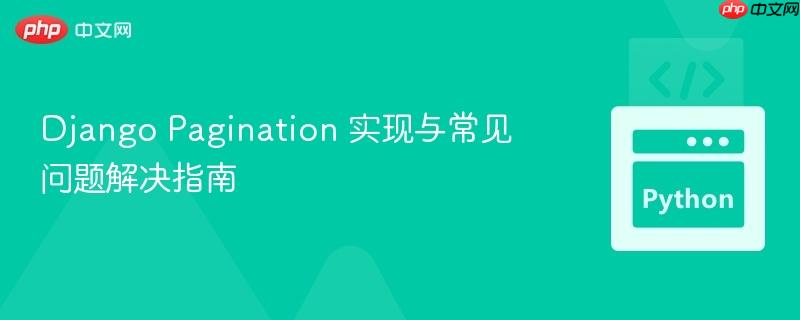
本教程详细阐述了如何在 django 项目中利用 listview 实现分页功能。内容涵盖了视图层面的配置,如 paginate_by 和 context_object_name,以及模板中分页链接的渲染。特别地,它解决了因模板中变量命名不一致(例如,误用 page 而非 page_obj)导致分页控件无法正确显示这一常见问题,并提供了清晰的修正方案。
在处理大量数据时,分页是提升用户体验和网站性能的关键技术。Django 提供了强大且灵活的分页功能,特别是通过其内置的 Paginator 类和基于类的视图 ListView,能够轻松实现数据的分批展示。本指南将详细介绍如何在 Django 项目中配置和使用 ListView 进行分页,并解决常见的显示问题。
Django 的 ListView 旨在简化列表数据的展示,并内置了对分页的支持。要实现分页,主要是在视图中配置 paginate_by 属性,并在模板中渲染相应的导航控件。
在 ListView 的子类中,通过设置 paginate_by 属性来定义每页显示的项目数量。同时,context_object_name 属性指定了在模板中访问分页对象时使用的变量名,这对于后续模板渲染至关重要。
# myapp/views.py
from django.views.generic import ListView
from .models import Product # 假设你的产品模型名为 Product
class ProductListView(ListView):
model = Product
template_name = 'Genesis/home.html'
context_object_name = 'page_obj' # 在模板中通过 'page_obj' 访问分页对象
paginate_by = 8 # 每页显示 8 个产品
def get_context_data(self, **kwargs):
"""
此方法用于向模板上下文中添加额外的数据。
尽管与分页核心功能无关,但它展示了如何扩展上下文。
"""
context = super().get_context_data(**kwargs)
# 假设 Product 模型有一个 Product_Type 字段,用于分类。
# 注意:这里获取了所有产品,如果产品数量巨大,可能需要优化查询。
categories = Product.objects.all()
context['categories'] = [
{'Product Type': category.Product_Type, 'Product Name': category.Product_Name}
for category in categories
]
return context在上述代码中:
在模板中,我们需要迭代当前页的产品列表,并生成分页导航控件。
ListView 提供的 page_obj 对象包含当前页的所有数据。你可以通过 page_obj.object_list 来访问这些数据。
{% if page_obj.object_list %} {# 检查当前页是否有产品 #}
<div class="row" id="product-container">
{% for product in page_obj.object_list %}
<div class="col-lg-3 col-md-6 mb-4">
<div class="card">
<!-- 产品图片 -->
<div class="bg-image hover-zoom ripple ripple-surface ripple-surface-light" data-mdb-ripple-color="light">
@@##@@
<a href="#!">
<div class="mask">
<div class="d-flex justify-content-start align-items-end h-100">
<h5><span class="badge bg-primary ms-2">New</span></h5>
</div>
</div>
<div class="hover-overlay">
<div class="mask" style="background-color: rgba(251, 251, 251, 0.15);"></div>
</div>
</a>
</div>
<div class="card-body">
<div class="text-center">
<!-- 产品名称 -->
<h5 class="fw-bolder">{{ product.Product_Type }}</h5>
<!-- 产品价格 -->
$40.00 - $80.00
</div>
</div>
<!-- 产品操作 -->
<div class="card-footer p-4 pt-0 border-top-0 bg-transparent">
<div class="text-center">
<a class="btn btn-outline-dark mt-auto" href="#">View Product</a>
</div>
</div>
</div>
</div>
{% endfor %}
</div>
{% else %}
<p class="text-center">No Products Available</p>
{% endif %}分页导航通常包括“上一页”、“下一页”链接和页码列表。这里最常见的错误是模板变量名与视图中 context_object_name 的设置不一致,导致分页控件无法正确显示。
常见问题:模板变量名不一致
当在视图中设置 context_object_name = 'page_obj' 时,模板中必须使用 page_obj 来访问分页对象。如果错误地使用了 page(例如 {% if page.has_previous %}),Django 模板将无法找到对应的分页对象,导致分页导航不显示。
解决方案:统一模板变量名
将模板中所有引用分页对象的变量名从 page 更正为 page_obj。
<nav aria-label="Page navigation ">
<ul class="pagination justify-content-center">
{# 上一页按钮 #}
{% if page_obj.has_previous %} {# 修正:使用 page_obj #}
<li class="page-item">
<a class="page-link" href="?page={{ page_obj.previous_page_number }}" aria-label="Previous"> {# 修正:使用 page_obj #}
<span aria-hidden="true">«</span>
</a>
</li>
{% endif %}
{# 页码列表 #}
{% for num in page_obj.paginator.page_range %} {# 修正:使用 page_obj #}
{% if page_obj.number == num %} {# 修正:使用 page_obj #}
<li class="page-item active"><a class="page-link" href="#">{{ num }}</a></li> {# 当前页高亮 #}
{% else %}
<li class="page-item">
<a class="page-link" href="?page={{ num }}">{{ num }}</a>
</li>
{% endif %}
{% endfor %}
{# 下一页按钮 #}
{% if page_obj.has_next %} {# 修正:使用 page_obj #}
<li class="page-item">
<a class="page-link" href="?page={{ page_obj.next_page_number }}" aria-label="Next"> {# 修正:使用 page_obj #}
<span aria-hidden="true">»</span>
</a>
</li>
{% endif %}
</ul>
</nav>在模板中,page_obj(或你自定义的 context_object_name)是一个 Page 对象实例,它提供了以下常用属性和方法来构建灵活的分页导航:

每个人都需要一台速度更快、更稳定的 PC。随着时间的推移,垃圾文件、旧注册表数据和不必要的后台进程会占用资源并降低性能。幸运的是,许多工具可以让 Windows 保持平稳运行。

Copyright 2014-2025 https://www.php.cn/ All Rights Reserved | php.cn | 湘ICP备2023035733号